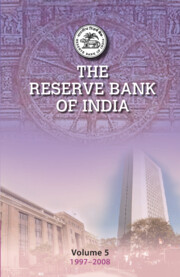Book contents
- Frontmatter
- Contents
- Tables
- Boxes
- Foreword
- Preface
- Acknowledgements
- List of Abbreviations
- 1 Introduction: Managing Liberalisation
- 2 The Macroeconomic Context
- 3 Monetary Management
- 4 Foreign Exchange Market and Management of the Capital Account
- 5 Foreign Exchange Reserves Management
- 6 Financial Markets
- 7 Public Debt Management
- 8 The Payment and Settlement Systems
- 9 Currency Management
- 10 Regulation of the Financial System – Part I: Commercial Banks
- 10 Regulation of the Financial System Part II: Other Financial Institutions
- 11 Supervision of the Financial System
- 12 Rural Credit
- 13 Financial Inclusion
- 14 Communication Policy
- 15 Organisational Change
- Appendices
- Photographs
- Select Bibliography
- Index
10 - Regulation of the Financial System Part II: Other Financial Institutions
Published online by Cambridge University Press: 10 January 2023
- Frontmatter
- Contents
- Tables
- Boxes
- Foreword
- Preface
- Acknowledgements
- List of Abbreviations
- 1 Introduction: Managing Liberalisation
- 2 The Macroeconomic Context
- 3 Monetary Management
- 4 Foreign Exchange Market and Management of the Capital Account
- 5 Foreign Exchange Reserves Management
- 6 Financial Markets
- 7 Public Debt Management
- 8 The Payment and Settlement Systems
- 9 Currency Management
- 10 Regulation of the Financial System – Part I: Commercial Banks
- 10 Regulation of the Financial System Part II: Other Financial Institutions
- 11 Supervision of the Financial System
- 12 Rural Credit
- 13 Financial Inclusion
- 14 Communication Policy
- 15 Organisational Change
- Appendices
- Photographs
- Select Bibliography
- Index
Summary
Introduction
In the decades after Independence, a set of financial institutions other than commercial banks were established under the government’s encouragement. The three most important types, which will form the subject of this chapter, were those known as all-India financial institutions or development financial institutions (FIs), non-banking financial companies (NBFCs) and urban cooperative banks (UCBs). The cooperative banking institutions in rural areas are covered later in the chapter on rural credit. These served specific types of clients, some of whom had inadequate access to commercial banks.
The relative share of assets of scheduled commercial banks (SCBs), FIs, NBFCs and UCBs as of March 1998 (comparable figures are not available for March 1997) and 2008 are shown in Table 10.2.1. Though the assets of these three categories had increased in absolute terms during the reference period, there was a fall in their market share and a rise in the market share of commercial banks. The commercial banks accounted for 94.3 per cent of public deposits in March 2008.
During the reference period, the regulatory framework applicable to these institutions underwent fundamental changes. Some FIs converted into banks, and the others tried to reinvent themselves. NBFCs and UCBs were subjected to regulations aimed at improving governance. The Bank, despite limited jurisdiction on these institutions, played a pivotal role in the transition. This chapter outlines the transition. The three main sections of the chapter deal with FIs, NBFCs and UCBs. The next section gives a brief overview of the three types of institutions and their relationship with the Reserve Bank.
Financial Institutions, Non-Banking Financial Companies and Urban Cooperative Banks
Financial Institutions (FIs)
The FIs were set up to extend long-term loans directly, and indirectly through banks and other agencies to meet the financial needs of industrialisation. Banks, on the other hand, supplied mostly working capital loans.
- Type
- Chapter
- Information
- The Reserve Bank of IndiaVolume 5, 1997–2008, pp. 428 - 477Publisher: Cambridge University PressPrint publication year: 2023



